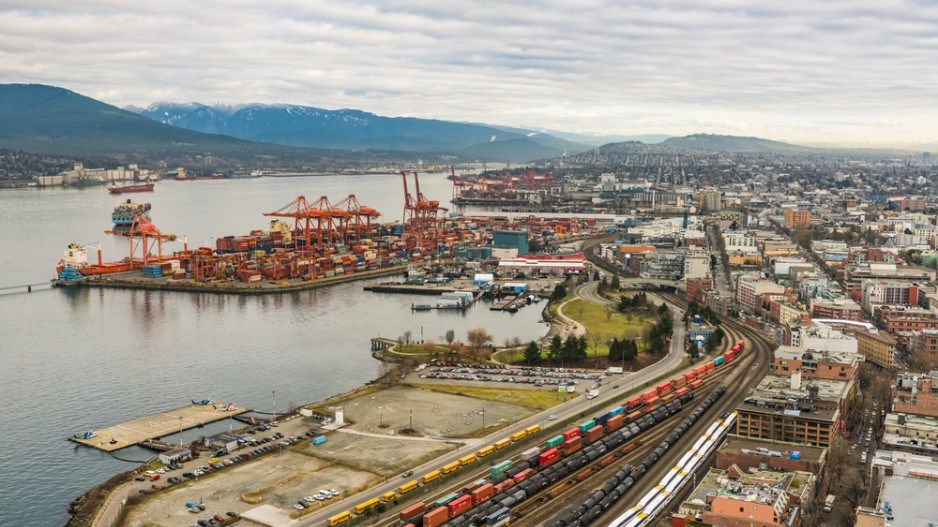Although vessel lineups at the Port of Vancouver have declined in the past week or so, they are still above historic levels, according to Canada’s Grain Monitoring Program (GMP).
In its most recent weekly report, the GMP reported that 11 grain vessels had cleared from Port of Vancouver in Week 33 and three others had cleared from the Port of Prince Rupert in northern B.C.
Those clearances reduced vessel lineups to 31 ships at the Port of Vancouver and six at Prince Rupert — numbers that are still well above normal.
Those numbers are high “but the vessel count has really come down,” said Mark Hemmes, president of Quorum Corp., the company contracted to manage the GMP.
“As of (March 24) we were down to 24 boats.”
The one-year average at Vancouver is 19 vessels.
Before the 2013-14 crop year, vessel counts in Vancouver were typically in the range of eight to 12.
Hemmes said a number of factors have contributed to historically high vessel numbers at Vancouver.
The most influential factor is weather.
“When you look at what the weather’s been like out there for the last 14-18 days, it’s nuts the amount of rain that they’ve been getting,” Hemmes said.
“The average rainfall (in the first half of March) was about eight millimetres a day; as a rule of thumb, if you get more than about five millimetres a day, you can count on it affecting ship loading.”
Other factors include avalanche and snow-related delays in mountainous areas and low ocean freight rates.
West Coast terminals are generally not equipped to load ships in the rain.
Vertical loading systems at some terminals allow for loading spouts and ship holds to be tented during rainy weather.
But most terminals have angled spouts that make tenting difficult or impossible.
In addition to high vessels numbers, the average time that each vessel stays in port is also up.
Time in port “has been really high in the last three to four months,” Hemmes said.
“In January-February, we were at about 18 days, which is horrendous. In the 2015 crops year, I think the average was about eight to 10 days.”
More ships at port combined with longer waiting times typically point to higher demurrage costs.
Terms for demurrage differ from contract to contract, but they are typically paid by shippers whenever a vessel is forced to wait for an extended period of time to receive its load.
Those payments are usually passed on to individual grain producers, and are reflected through basis levels or built into commodity prices or elevation fees at country delivery points.
It is difficult to estimate how much demurrage charges cost the western Canadian grain industry, but long vessels lineups at the West Coast and longer-than-average wait times are a certain indication that demurrage costs are quickly accumulating.
The current price of a Panamax-sized vessel off the West Coast is estimated at around $8,700 per day.
In general, demand for ocean freight has been soft for the past year or more, so shippers may be able to negotiate more favourable demurrage terms.
In some cases, ships may forfeit demurrage and stay at anchor for longer periods as they wait for a loading berth.
Disruptions in west coast loading have also affected available working capacity at terminals.
Grain stocks in store at west coast terminals increased to 1.4 million tonnes in Week 32.
That’s about 81% of terminal working capacity, the GMP reports stated.
That number is relatively high, but it could drop quickly if the weather co-operates, especially given that so many ships are waiting to load.
Elevator capacity at rural delivery points is also reaching “concerning” levels, Hemmes said.
As of March 21, grain stocks at country elevators has increased to 3.9 million tonnes, using 84% of working capacity.
Wade Sobkowich, executive director of the Western Canadian Grain Elevators Association (WGEA) said grain movements are still reasonably good, despite loading delays at port and limited available capacity at many country elevator locations.
He said used elevator capacity “is in the 80s, but we’ve been in the 80s for some weeks now and we haven’t seen a big change over the last month or two.”
“Same thing with vessel lineups,” he added.
“Thirty-one grain vessels is a high number but … it’s been in the high 20s for some time now.”
Sobkowich acknowledged that ship loading delays at port combined with rail car allocation delays has caused delivery problems at some elevator locations.
But overall, grain is moving reasonably well.
“We haven’t been hearing … system-wide complaints about not being able to deliver into the system, although I know that there have been some pockets here and there … where delivery has been delayed,” he said.
“For the most part, farmer access to the elevator system is OK.”




